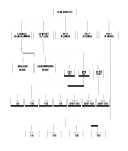
CHAPTER 1
GENERAL
- COMPOSITION.--
- General.--The rifle company is the basic infantry unit with administrative and supply functions. The company consists of a company headquarters, three rifle platoons, and one weapons platoon. (See fig. 1.)

Figure 1
Composition of rifle company.
